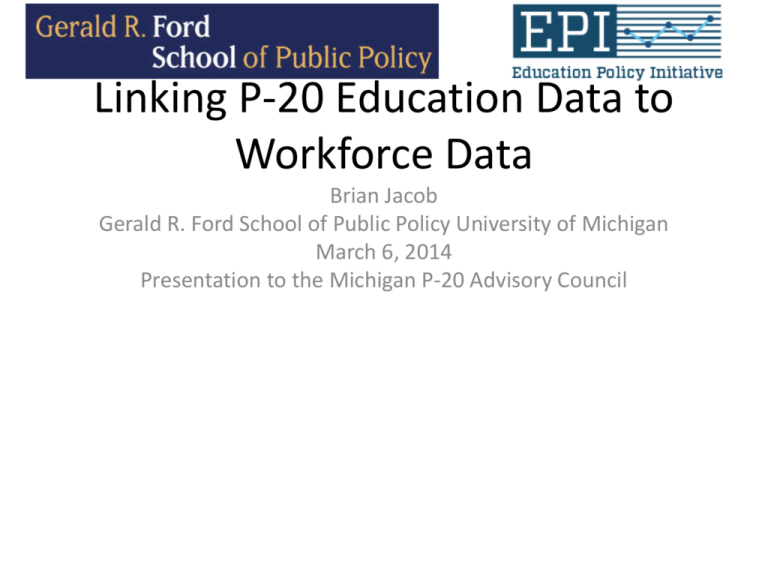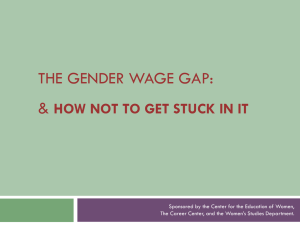Linking P-20 Education Data to Workforce Data
advertisement

Linking P-20 Education Data to Workforce Data Brian Jacob Gerald R. Ford School of Public Policy University of Michigan March 6, 2014 Presentation to the Michigan P-20 Advisory Council Agenda • Benefits of data linkage – What other states are doing • An example from Michigan – CAPSEE Project: Linking wage records with CC transcript data in Michigan • Some specific opportunities in Michigan • Questions/discussion Benefits of data linkage • Labor market information (LMI) is important as an outcome as well as a contextual factor that predicts many early school outcomes • LMI as an outcome – – – – Impact of CTE programs (high school or CC) Long-term impact of elementary or secondary initiatives Economic returns across different types of degrees Link btw/ content and workforce prep • LMI as an independent variable – Importance of family income & parental employment in early schooling outcomes – Relationship between LMI and participation/success in early childhood education Data Linking in Other States • Many states linking education and labor force data – TX and FL: long-standing P-20 -> Workforce (UI) links – WA recently added K-12 to PostSec-UI link – NC, VA, CA: long-standing links btw/ PostSec & UI • Analyses that utilize linked data – Do students’ college major choice respond to changes in wages? (Washington State) – What are the economic returns to CC degrees and certificates? (Virginia, North Carolina, Florida, California) – What are the long-run economic benefits of starting at a 4yr vs. 2-yr college? (Texas) CAPSEE Michigan • CAPSEE (Center for Analysis of Postsecondary Education and Employment) – IES funded research center to explore the association between various postsecondary pathways and employment and earnings • Collaboration btw/ UM and 5 CCs in Michigan – Macomb, Oakland, Jackson, Washtenaw and Alpena • Motivating research questions – What are the economic returns to CC in Michigan? • Does this vary by award type (e.g., AA, cert.), field (e.g., allied health, advanced manufacturing), student demographics (e.g., age, gender)? – Quick turnaround analyses tailored to college-specific needs CAPSEE Michigan: Data • Detailed student transcript data from 5 CCs from 20012011 – Includes info on course-taking, award receipt, student demographics, course of study, financial aid and remediation – Personal identifiers (including SSN) provided for matching purposes only – Matched to NSC records from 1995-2012 • Linked to UI wage records from 1998q2 – 2011q2 – We conducted the match ourselves on a non-networked computer in LARA’s office in Detroit – We just take the non-identified data back with us (no SSN’s out in the open) – Maintain data on secure servers at UM with access limited to a select set of researchers (who have all signed confidentiality agreements) CAPSEE Michigan: Analysis • Multivariate regression to control for differences between individuals with and without CC degrees • Fixed effect regression models that compare an individual’s employment and earnings after she gets a degree with her own prior labor market outcomes • Matching estimators that compare individuals who receive a degree with others that look like them in terms of demographics and prior employment/earnings CAPSEE Michigan: Preliminary Findings Earnings and employment gains realized by MI community college students Women Men Short Cert Certificate Associates Short Cert Certificate Associates Quarterly $0 $620 $2,346 $1,345 $ 918 $1,441 earnings gains Increased prob. of employment 4% 5% 14% 4% 8% 9% Log quarterly earnings gains 0% 13% 32% 0-8% 0-4% 12% Distribution of awards by field Returns by field of study Earnings gains by field of study Liberal arts STEM Business Health Vocational, tech Vocational, non-technical * Indicates significance level of p>.1 or greater. Certificate $-218 $411 $257 $1,698* $976 $116 Associates $-488* $84 $41 $3,894* $926* $-71 Responding to CC Needs: Example 1 1. Online course taking at MCC • Between 2003 and 2010, share of students taking an online course in their 1st year rose from 6.5% to 15% (w/in 3 years from 13.4% to 23%) – Gap for women over men rose from 3% to 8% – Gap for 25+ year-olds vs. under 25 rose from 3% to 7% – Students online in their first year take ½ of first-year credits online. • Pass rates are 5-10% lower for students in online courses than for students in face-to-face courses • Online courses play an important role in allowing students to remain connected to the labor force – i.e., reduces the “opportunity cost” of college – Conditional on the total number of credits taken, students taking a higher fraction of courses online realize a lower drop in earnings while enrolled (relative to preenrollment) Responding to CC Needs: Example 2 2. School-specific reports • Provided school specific measures of employment and earnings by degree and field of study • Hosted conference to help senior staff interpret results • We have continued to respond to follow-up requests Responding to CC Needs: Example 2 2. School-specific reports TABLE 6. Earnings and Employment for award recipients in Quarter 2 of 2011, by program Earnings > Quarterly Quarterly Employed half time at earnings if earnings employed min. wage Associate in Arts (AA) 0.64 0.57 3,922 6,101 Associate in General Studies 0.69 0.65 4,622 6,670 (AGS) Business Administration (AAS) 0.71 0.67 5,025 7,123 Nursing (AAS) 0.83 0.82 10,625 12,775 Associate in Science (AS) 0.72 0.63 6,226 8,688 Practical Nursing Certificate 0.83 0.81 8,660 10,392 Medical Assistant (AAS) 0.87 0.87 6,719 7,753 Accounting (AAS) 0.68 0.66 4,269 6,239 Medical Assistant Certificate 0.8 0.77 4,374 5,468 Law Enforcement (AAS) 0.65 0.62 4,552 6,954 Notes: Sample is students who first enrolled at JCC in or after Fall 2001, and who were not enrolled in any school in quarter 2 of 2011. Employed is defined as having any earnings reported in Unemployment Insurance records. Earnings>half time at min. wage equals 1 if quarterly earnings are Future Plans: Automating links between CC and UI • Community colleges have reporting requirements • Gainful employment, WIA, Pell, etc. • They’re forced to use their own surveys to get these numbers. • LARA/DTMB has wage records for any of these students working in MI • The idea: automate the process and provide aggregate data • Colleges send lists of SSN’s to LARA/DTMB for selected student groups • LARA/DTMB sends back the share employed and median/mean earnings for that group of students • No individual records are ever sent • The program is automated so colleges just upload the list of SSN’s • The resulting data can be used by schools/researchers/gov’t Automating links between CC and UI California community colleges have something like this already: http://salarysurfer.cccco.edu/SalarySurfer.aspx And an even more detailed version at the college level: http://datamart.cccco.edu/Outcomes/College_Wage_Tracker.aspx From this site: • Students can look up pre- and post-award earnings, by degree. • Government researchers and policy makers can use this information to evaluate the effectiveness of programs in matching students to jobs. • Schools can use this the access to data for performance requirements, without their own surveys or ever having individual student outcomes. Is this really possible in Michigan? • With the help of Tom Howell and others at CEPI & MDE, we have already made tremendous strides in linking K-20 data • CAPSEE Michigan has demonstrated the feasibility of linking CC-UI in a secure setting • While we are waiting for the Holy Grail, an independent, non-state entity (e.g., the Ed Policy Initiative at UM) can develop and host something like CA’s wage tracker – Michigan public colleges provide SSNs for data that already exists in STAR – Match to workforce data provided by LARA, following protocols established by CAPSEE – Develop website that will allow the public access to aggregated data with a minimum cell size Questions? For more information on CAPSEE Michigan and related projects, see our website: Education Policy Initiative Ford School of Public Policy University of Michigan http://www.edpolicy.umich.edu/







